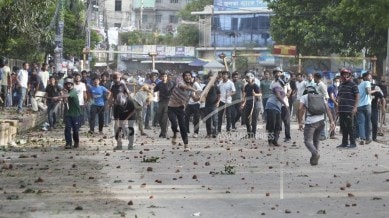Stay updated with the latest - Click here to follow us on Instagram
Why violent clashes have erupted in varsities across Bangladesh
The protests were sparked by a recent decision by Bangladesh's High Court to reinstate a 30% government job quota for the descendants of those who fought in the country's 1971 war of independence.

Violent clashes have erupted at universities across Bangladesh as students protest the government’s job quota system, leaving scores injured. The protests were sparked by a recent decision by Bangladesh’s High Court to reinstate a 30% government job quota for the descendants of those who fought in the country’s 1971 war of independence. While the protesters support quotas for other marginalized groups like women, ethnic minorities, and the disabled, they are demanding the 30% quota for war veterans’ families be scrapped.
“We are not against the quota system in general, but we want the 30% quota for the descendants of 1971 freedom fighters to be abolished,” Nahid Islam, the coordinator of the anti-quota protests told Reuters. “Government jobs are the only hope for many young people in Bangladesh, and this quota system is depriving them of opportunities.”
monthly limit of free stories.
with an Express account.
Violent confrontations between protesters and pro-government student groups
The violence first erupted on Monday at Dhaka University, the country’s leading public university, where over 100 students were injured in clashes between protesters and members of the student wing of the ruling Awami League party, the Bangladesh Chhatra League (BCL).
The unrest then spread to Jahangir Nagar University in Savar, outside the capital Dhaka, on Tuesday morning. At Jahangir Nagar University, protesters had gathered in front of the vice-chancellor’s residence early Tuesday when they were attacked by BCL activists and police, according to witnesses. Over 50 people were treated overnight at a nearby hospital, with at least 30 suffering pellet wounds.
“The protesters were staging a peaceful demonstration when they were suddenly attacked by the BCL and the police,” said Abdullahil Kafi, a senior police official told the country’s leading English-language newspaper Daily Star, the AP reported. “We had to use tear gas and blank rounds to disperse the crowd as the protesters became violent and started attacking us.” The protesters, however, accused the BCL and police of instigating the violence.
Government defends quota system as honouring 1971 Independence struggle
The job quota system in Bangladesh reserves 56% of government positions for various groups, including 30% for the descendants of 1971 independence war veterans, 10% for women, 10% for people from underdeveloped districts, 5% for indigenous communities, and 1% for people with disabilities. The system was suspended in 2018 after similar protests, but the High Court last month ordered the government to reinstate the 30% quota for war veterans’ families. This triggered the latest wave of demonstrations, with protesters arguing the quota unfairly prioritizes one group over others.
Hasina’s Awami League party, which led the 1971 independence war, has defended the quota system, arguing it is necessary to honour the sacrifices of the war veterans and their families. The party has also accused the protesters of being “Razakars” – a term used for those who allegedly collaborated with the Pakistani army during the 1971 war.
Opposition joins fray
The unrest has also taken on a political dimension, with the main opposition Bangladesh Nationalist Party (BNP) and its student wing calling for marches on Wednesday to protest the attacks on the anti-quota protesters. This inflammatory rhetoric has further inflamed tensions, with the protesters rejecting the “Razakar” label and accusing Sheikh Hasina’s government of using divisive tactics to cling to power.
Calls for fair solution
As the unrest continues to simmer on university campuses, analysts warn that the government’s heavy-handed response and failure to address the protesters’ legitimate grievances could further fuel public anger and instability in the country.
“The government needs to find a way to listen to the students’ concerns and find a fair solution to this quota issue,” Mohammad Abdur Razzaque, chairman of Research and Policy Integration for Development told Reuters.
“Resorting to violence and labelling the protesters as anti-national forces is only going to exacerbate the situation and deepen the divisions in Bangladeshi society,” he said.
(With inputs from Reuters, AP, and PTI)